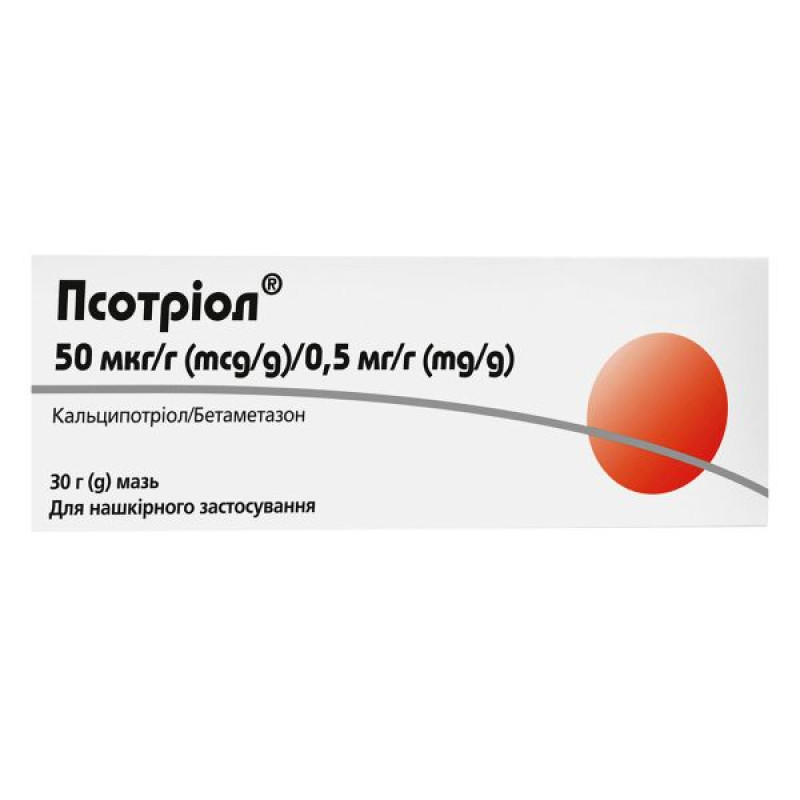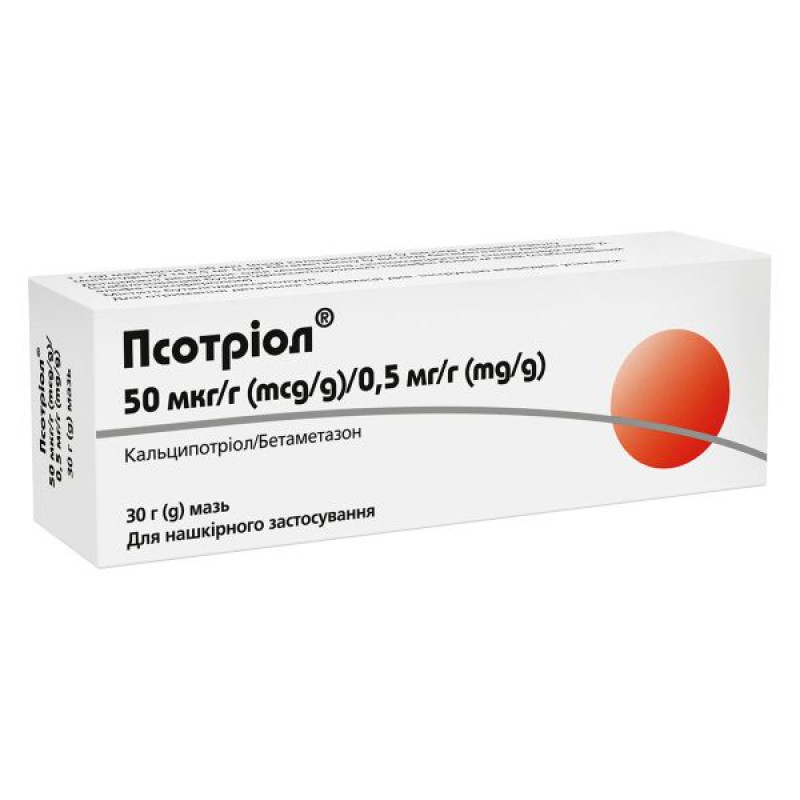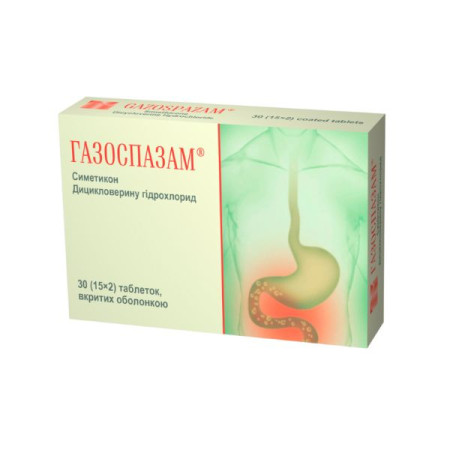Psotriol ointment 50 mcg/g/0.5 mg/g tube 30 g

Instructions Psotriol ointment 50 mcg/g/0.5 mg/g tube 30 g
Composition
active ingredient: betamethasone, calcipotriol;
1 g of ointment contains 50 μg of calcipotriol (as calcipotriol monohydrate) and 0.5 mg of betamethasone (as betamethasone dipropionate);
excipients: polyoxypropylene stearyl ether (stabilized with butylhydroxytoluene), white soft paraffin (stabilized with alpha-tocopherol), mineral oil.
Dosage form
Ointment.
Main physicochemical properties: shiny, homogeneous ointment from white to yellowish color without foreign particles.
Pharmacotherapeutic group
Topical antipsoriatic agents. Other topical antipsoriatic agents. Calcipotriol, combinations.
ATX code D05A X52.
Pharmacological properties
Pharmacodynamics
Calcipotriol is a vitamin D analogue. In vitro studies have shown that calcipotriol inhibits keratinocyte proliferation and promotes morphological differentiation. This is a likely mechanism of action in psoriasis. Like other topical corticosteroids, betamethasone dipropionate has anti-inflammatory, antipruritic, vasoconstrictor and immunosuppressive properties, but does not treat the underlying disease. The use of occlusive dressings enhances the therapeutic effect by increasing penetration into the stratum corneum. This may increase the incidence of adverse reactions. In general, the mechanism of anti-inflammatory activity of topical steroids is not fully understood.
A safety study in 634 patients with psoriasis investigated repeated courses of treatment with calcipotriol + betamethasone dipropionate ointment applied once daily as recommended either as monotherapy or alternating with calcipotriol ointment for up to 52 weeks compared to calcipotriol ointment as monotherapy for 48 weeks after the initial course of calcipotriol + betamethasone dipropionate ointment. Adverse drug reactions were reported in 21.7% of patients in the calcipotriol + betamethasone dipropionate ointment group, 29.6% of patients in the calcipotriol + betamethasone dipropionate ointment group alternating with calcipotriol ointment, and 37.9% of patients in the calcipotriol ointment group. Adverse drug reactions reported in more than 2% of patients in the calcipotriol + betamethasone dipropionate ointment group were pruritus (5.8%) and psoriasis (5.3%). Adverse drug reactions possibly related to long-term corticosteroid use (e.g. skin atrophy, folliculitis, depigmentation, furuncles and purpura) were reported in 4.8% of patients in the calcipotriol + betamethasone dipropionate ointment group, 2.8% of patients in the calcipotriol + betamethasone dipropionate/calcipotriol ointment alternating group, and 2.9% of patients in the calcipotriol ointment group.
The adrenal response to adrenocorticotropic hormone (ACTH) was assessed by measuring serum cortisol levels in patients with widespread psoriasis of both the scalp and other body areas using up to 106 g of a combination of calcipotriol + betamethasone dipropionate gel and calcipotriol + betamethasone dipropionate ointment per week. A marginal decrease in cortisol secretion in response to ACTH stimulation was observed in 5 of 32 patients (15.6%) after 4 weeks of treatment, and in 2 of 11 patients (18.2%) who continued treatment for up to 8 weeks. In all cases, serum cortisol levels were within normal limits 60 minutes after ACTH stimulation. There was no evidence of altered calcium metabolism in these patients. Thus, with regard to suppression of the hypothalamic-pituitary-adrenal axis, this study provided some evidence that very high doses of gel and ointment containing calcipotriol + betamethasone dipropionate may have a weak effect on hypothalamic-pituitary-adrenal axis function.
Pediatric patients
The adrenal response to ACTH stimulation was evaluated in an uncontrolled 4-week study in 33 adolescents aged 12-17 years with psoriasis of the body who used up to 56 g of calcipotriol + betamethasone dipropionate ointment per week. There were no reports of hypothalamic-pituitary-adrenal axis suppression. No cases of hypercalcemia were reported, but one patient had an increase in urinary calcium levels, possibly related to treatment.
Pharmacokinetics
After systemic exposure, both active ingredients – calcipotriol and betamethasone dipropionate – are rapidly and extensively metabolized. The drug is approximately 64% protein bound. The plasma half-life of the drug after intravenous administration is 5-6 hours. Due to the formation of a depot in the skin, the elimination of the drug from the skin after cutaneous application occurs within several days.
Betamethasone is metabolized primarily in the liver, but also in the kidneys to form glucuronides and sulfoesters. The main route of excretion for calcipotriol is via the faeces (in rats and minipigs) and for betamethasone dipropionate is via the urine (in rats and mice). In rats, tissue distribution studies of radiolabelled calcipotriol and betamethasone dipropionate showed that the kidneys and liver had the highest levels of radioactivity.
Calcipotriol and betamethasone dipropionate levels were below the lower limit of quantification in all blood samples from 34 patients treated for 4 or 8 weeks with either a gel containing calcipotriol + betamethasone dipropionate or an ointment containing calcipotriol + betamethasone dipropionate for extensive psoriasis on both the body and the scalp. One metabolite of calcipotriol and one metabolite of betamethasone dipropionate were quantifiable in some patients.
Indication
Topical treatment of stable plaque psoriasis vulgaris amenable to topical therapy in adults.
Contraindication
Hypersensitivity to the active substances or to any of the excipients of the medicinal product listed in the "Composition" section.
The use of the drug Psotriol, ointment, is contraindicated in patients with psoriatic erythroderma, exfoliative and pustular psoriasis.
Due to the content of calcipotriol, Psotriol ointment is contraindicated in patients with known disorders of calcium metabolism (see section "Special instructions").
Due to the content of the corticosteroid Psotriol, ointment, is contraindicated in the following diseases: skin lesions of viral etiology (for example, herpes or chickenpox), fungal or bacterial skin infections, parasitic infections, skin manifestations of tuberculosis, perioral dermatitis, skin atrophy, atrophic skin stripes, increased vascular fragility, ichthyosis, acne vulgaris, acne rosacea, rosacea, ulcers and wounds (see the section "Peculiarities of use").
Interaction with other medicinal products and other types of interactions
No drug interaction studies with Psotriol ointment have been conducted.
Application features
Impact on the endocrine system
Psotriol ointment contains a potent Group III steroid. Concomitant treatment with other steroids should be avoided. Adverse reactions that occur with systemic corticosteroid therapy, such as adrenal suppression or effects on the metabolic control of diabetes, may also occur with topical corticosteroids due to systemic absorption. Application under occlusive dressings should be avoided as this increases systemic absorption of corticosteroids.
You should also avoid using the drug on large areas of damaged skin or on mucous membranes, or in skin folds, as this increases the systemic absorption of corticosteroids (see section "Adverse reactions").
In a study of patients with both widespread scalp psoriasis and widespread psoriasis of other parts of the body who used a combination of a gel containing calcipotriol + betamethasone dipropionate at high doses (application of the drug to the scalp) and an ointment containing calcipotriol + betamethasone dipropionate at high doses (application of the drug to other parts of the body), a marginal decrease in cortisol excretion in response to ACTH stimulation was observed in 5 of 32 patients after 4 weeks of treatment (see section "Pharmacodynamics").
Effect on calcium metabolism
Due to the content of calcipotriol, hypercalcemia may develop if the maximum daily dose (15 g) is exceeded. Serum calcium levels return to normal upon discontinuation of treatment. The risk of hypercalcemia is minimal if the recommendations for calcipotriol are followed. The drug should not be applied to skin areas exceeding 30% of the body surface (see section "Method of administration and dosage").
Local adverse reactions
Psotriol, an ointment, contains a potent Group III steroid. Concomitant treatment with other steroids at the same site should be avoided. The skin of the face and genitals is very sensitive to corticosteroids, so the drug should not be used on these areas. The patient should be instructed in the correct use of the drug to prevent application or accidental contact with the face, mouth or eyes. Hands should be washed after each application of the drug to prevent accidental contact with these areas of the body.
If the lesions are complicated by secondary infection, antibacterial therapy should be administered. However, if the infection worsens, corticosteroid treatment should be discontinued (see Contraindications).
Therapy withdrawal
When treating psoriasis with topical corticosteroids, there is a risk of generalized pustular psoriasis or rebound effects upon drug withdrawal. Therefore, continued medical supervision is necessary after discontinuation of the drug.
Long-term use of the drug
The risk of local or systemic adverse reactions increases with long-term use of corticosteroids. The drug should be discontinued if adverse reactions associated with long-term use of corticosteroids occur (see section "Adverse reactions").
Application not evaluated
There is no experience with the use of the drug Psotriol, ointment, in patients with guttate psoriasis.
Concomitant treatment and UV irradiation
To date, there are only limited data on the use of this medicinal product on the hairy part of the head.
Calcipotriol + betamethasone dipropionate ointment has been used in combination with calcipotriol + betamethasone dipropionate gel for the treatment of psoriatic lesions on the scalp, but experience with the combination of calcipotriol + betamethasone dipropionate with other antipsoriatic medicinal products for topical application to the same area, with other antipsoriatic medicinal products used systemically, or with phototherapy is limited.
Patients should be advised to limit or avoid excessive exposure to natural or artificial light while using Psotriol ointment. Topical calcipotriol should not be used with UVA unless the physician and patient consider that the expected benefit outweighs the potential risk.
Vision impairment
Visual impairment may occur with systemic or topical corticosteroids. If a patient presents with symptoms such as blurred vision or other visual disturbances, they should be referred to an ophthalmologist to determine possible causes, which may include cataracts, glaucoma, or a rare condition called central serous chorioretinopathy (CSCR), which has been reported following the use of systemic and topical corticosteroids.
Adverse reactions to excipients
Psotriol, ointment, contains butylhydroxytoluene as an excipient, which may cause local skin reactions (e.g. contact dermatitis) or irritation of the eyes and mucous membranes.
Use during pregnancy or breastfeeding
Pregnancy
There are currently no adequate data on the use of Psotriol, ointment in pregnant women. Animal studies with glucocorticosteroids have shown reproductive toxicity, but a number of epidemiological studies (less than 300 pregnancy outcomes) have not revealed any congenital anomalies in infants born to mothers exposed to corticosteroids during pregnancy. The potential risk to humans has not yet been determined. Therefore, Psotriol, ointment, should be used during pregnancy only if the expected benefit justifies the potential risk.
Breastfeeding period
Betamethasone passes into breast milk, but adverse reactions in the child are unlikely when using the drug in therapeutic doses. There are no clinical data on the excretion of calcipotriol into breast milk. Psotriol ointment should be prescribed to women during breastfeeding with caution. Patients should not apply Psotriol ointment to the mammary glands during breastfeeding.
Fertility
Studies in rats with oral administration of calcipotriol or betamethasone dipropionate did not reveal any reduction in male or female fertility.
Ability to influence reaction speed when driving vehicles or other mechanisms
Psotriol, ointment, has no or negligible influence on the ability to drive or use machines.
Method of administration and doses
Doses
Psotriol, an ointment, should be applied to the affected areas of the skin once a day.
The recommended treatment period is 4 weeks. There is experience with repeated courses of Psotriol ointment for a period of up to 52 weeks. If after 4 weeks it is necessary to continue or resume the use of the drug, this should be done only after consulting a doctor and under regular medical supervision. When using drugs containing calcipotriol, the maximum daily dose should not exceed 15 g. The area of application of drugs containing calcipotriol should not exceed 30% of the body surface (see section "Special instructions").
Special patient groups
Patients with renal and hepatic impairment
The safety and efficacy of Psotriol ointment in patients with severe renal impairment or severe liver disease have not been established.
Children
The safety and efficacy of Psotriol ointment in children under 18 years of age have not been established. The currently available data on the use of the medicinal product in children aged 12 to 17 years are described in the sections “Pharmacodynamics” and “Adverse reactions”, but no dosage recommendations can be made.
Overdose
The use of the drug in doses exceeding the recommended dose may cause an increase in serum calcium levels, which resolves upon discontinuation of treatment. Symptoms of hypercalcemia include polyuria, constipation, muscle weakness, confusion and coma.
Excessive prolonged use of topical corticosteroids may suppress pituitary-adrenal function with the development of secondary adrenal insufficiency, which is usually reversible. In such cases, symptomatic treatment is indicated.
In case of chronic toxicity, corticosteroids should be gradually withdrawn.
It has been reported that, as a result of incorrect use of the medicinal product, one patient with widespread erythrodermic psoriasis, who was treated with 240 g of calcipotriol + betamethasone dipropionate ointment weekly (corresponding to a daily dose of approximately 34 g) for 5 months (the maximum recommended dose is 15 g per day), developed Cushing's syndrome during treatment and subsequently pustular psoriasis after abrupt discontinuation of treatment.
Adverse reactions
The assessment of the frequency of adverse reactions is based on a generalized analysis of clinical trial data, including post-marketing safety studies and spontaneous reports.
The most commonly reported adverse reactions during treatment are various skin reactions such as itching and peeling of the skin.
Cases of pustular psoriasis and hypercalcemia have been reported.
Adverse reactions are listed according to MedDRA system organ class (SOC) and frequency. Within each frequency grouping, adverse reactions are presented in order of decreasing seriousness.
| Infectious and parasitic diseases | |
| Uncommon (≥1/1000, | Skin reactions*, folliculitis |
| Rare (≥1/10,000, | Furuncle |
| On the part of the immune system | |
| Rare (≥1/10,000, | Increased sensitivity |
| Metabolism and nutrition | |
| Rare (≥1/10,000, | Hypercalcemia |
| From the organs of vision | |
| Frequency not known (cannot be estimated from the available data) | Blurred vision (see also section "Special warnings and precautions for use") |
| Skin and subcutaneous tissue disorders | |
| Common (≥1/100, | Skin peeling, itching |
| Uncommon (≥1/1000, | Skin atrophy, psoriasis exacerbation, dermatitis, erythema, rash**, purpura or ecchymosis, skin burning sensation, skin irritation |
| Rare (≥1/10,000, | Pustular psoriasis, striae, photosensitivity reactions, acne, dry skin |
| General disorders and administration site conditions | |
| Uncommon (≥1/1000, | Pigmentation changes at the site of drug application, pain at the site of drug application *** |
| Rare (≥1/10,000, | The ricochet effect |
*Skin infections, including bacterial, fungal, and viral skin infections, have been reported.
**Various types of rashes have been reported, such as exfoliative rash, papular rash, and pustular rash.
*** Burning sensation at the site of application of the drug is included in application site pain.
Pediatric patients
In an uncontrolled open-label study, 33 adolescents aged 12-17 years with psoriasis vulgaris were treated with an ointment containing calcipotriol + betamethasone dipropionate for 4 weeks up to a maximum dose of 56 g per week. No new adverse events or any concerns regarding systemic corticosteroid effects were identified. However, the size of this study does not allow for definitive conclusions to be drawn regarding the safety profile of Psotriol ointment when used in children and adolescents.
The adverse reactions listed below are considered to be related to the pharmacological classes of calcipotriol and betamethasone, respectively.
Calcipotriol
Adverse reactions include application site reactions, pruritus, skin irritation, burning and stinging sensation, dry skin, erythema, rash, dermatitis, eczema, exacerbation of psoriasis, photosensitivity and hypersensitivity reactions which may include in very rare cases angioedema and facial oedema.
Very rarely, systemic reactions may occur after topical application, leading to hypercalcemia or hypercalciuria (see section "Special warnings and precautions for use").
Betamethasone (as dipropionate)
After topical application, reactions at the application site may develop, especially during prolonged use, including the development of skin atrophy, telangiectasias, striae, folliculitis, hypertrichosis, perioral dermatitis, allergic contact dermatitis, depigmentation and colloid degeneration of the skin.
Systemic reactions associated with topical corticosteroids are rare in adults. However, they may be severe. Adrenal suppression, cataracts, infections, effects on metabolic control of diabetes mellitus, and increased intraocular pressure may occur, especially after long-term use of the drug. Systemic reactions are more likely to occur with the use of occlusive dressings (plastic, skin folds), when the drug is applied to large areas, and during long-term treatment (see section "Special instructions").
Reporting of suspected adverse reactions
Reporting of suspected adverse reactions during post-marketing surveillance is very important. This allows monitoring of the benefit-risk balance of medicinal products. Healthcare professionals should report any suspected adverse reactions.
Expiration date
3 years. After first opening – 1 year.
Storage conditions
Store at a temperature not exceeding 25 °C. Do not refrigerate. Keep out of the reach of children.
Packaging
30 g in a tube; 1 tube in a pack.
Vacation category
According to the recipe.
Producer
mibe GmbH Arcnaymittel.
Location of the manufacturer and its address of place of business.
Münchenerstrasse 15, Brena, Saxony-Anhalt, 06796, Germany.
There are no reviews for this product.
There are no reviews for this product, be the first to leave your review.
No questions about this product, be the first and ask your question.




